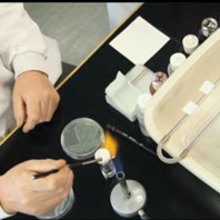Schoolzone: Practical microbiology in schools
Issue: Biogeography
27 August 2013 article

The importance of practical work in science is widely accepted, and it is acknowledged that quality practical work motivates students and promotes engagement (SCORE). It enables students to acquire skills from both laboratory and field-based work, it supports the learning of scientific knowledge and promotes an understanding of the key concepts that underpins learning. I listen – I forget, I look – I remember, I do – I understand (Hodson).
Studies over time have collected teachers’ views on the aims of practical work. Work by Kerr in 1964, Beatty & Woolnough published in 1982 and Swain and colleagues in 1998 all showed that four aims remained constant with teachers, regardless of the kind of practical work being done:
- to encourage accurate observation and description
- to make phenomena more real
- to arouse and maintain interest
- to promote a logical and reasoning method of thought.
These aims still apply to practical work done in schools today.
With their small size, rapid growth rate and relatively low cost, microbes are ideal for practical work in schools. Unlike many organisms, they do not necessarily have to be maintained over long periods and do not have to be fed and watered at weekends! Apart from their fundamental importance, micro-organisms can be used to demonstrate principles of biology just as well as plants and animals. For example, algae can be used to teach photosynthesis. They can also be used to model industrial processes, as well as offering opportunities for teaching across the curriculum. Practical microbiology also offers scope for quantitative project work providing data, which can be analysed using statistical techniques.
Teachers can be put off using microbiological investigations because of worries about safety, but reassurance is available from the SGM on all safety issues. The Society can provide information on where to find resources, including cultures, and offer many suggestions for suitable and safe investigations. More information is available from the Society’s dedicated educational website.
To support the teaching of practical microbiology the Society provides two practical manuals free to schools, Basic Practical Microbiology and Practical Microbiology for Secondary Schools, which give introductions on practical microbiology and provide a range of microbiological investigations to try. The two manuals are supported by short videos demonstrating basic practical microbiology techniques available on the Microbiology Today website.
In 2012, to further support practical microbiology teaching in schools, the Society published, Algae: a practical resource for secondary schools. The first copy is free to school members. The price to non-members is £15. Algae are common, easy and safe to handle, easy to source and cheap to use. They can be used to illustrate a range of topics, including:
- bioluminescence
- eutrophication
- gas cycling
- microscopy
- phototaxis
As well as practical activities, the SGM produces a wide range of microbiology teaching resources for all age groups from primary to post-16. The material is carefully targeted to meet curriculum requirements and fit with the specifications for science learning.
Visit the SGM resources page for information.
If you have any ideas for future resources or have any questions about teaching practical microbiology in schools, please do not hesitate to get in touch with our Education and Outreach Officer, Theresa Hudson: [email protected].
Dariel Burdass, SGM
Further reading
Beatty, J.W. & Woolnough, B.E. (1982). Why do practical work in 11–13 science? School Science Review 63, 758–770.
Hodson, D. (1993). Rethinking old ways: towards a more critical approach to practical work in school science. Studies in Science Education 22, 85–142.
Hodson, D. (1998). Teaching and Learning in Science: Exploring and Developing Personal Understanding Through Practical Work. Open University Press.
Kerr, J.F. (1963). Practical Work in School Science: an enquiry into the nature and purpose of practical work in school science in England and Wales. Leicester: Leicester University Press.
Science Community Representing Education (SCORE) Practical Work in Science: a report and proposal for a strategic framework.
